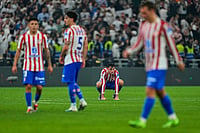IT'S 11.30 am on the first Monday of the month. A steady stream of men, women and children troop into the ramshackle shed in Vysarpadi in north Madras and group together according to their respective guilds. The decibel level is high for the auction is about to begin. The areas of operation are marked out and the bidding is furious for lucrative zones—Rs 5,000 a month for the Armenian Street Church for Sunday mornings, Rs 3,500 a month for the Annanagar Ayappan Temple during the festival season. For the 5,000 beggars of Madras, it's just another trade honed to perfection. A system devised through collective effort to not only resolve internal rivalries but also to maximise their earnings.
In Madras, there are about 20 such guilds of "people who accept alms" (they are not" alms seekers" but "alms receivers") controlled by a federation headquartered at Vysarpadi where they meet every Monday—the beggars' off-day. The city is divided into 25 zones; areas which have the potential to net the highest income are auctioned and groups allotted specific areas. Bidding is high for begging before temples on Tuesdays, mosques on Fridays and churches on Sundays—the sabbath being the day they rake in the highest earnings. Says K. Venkatachalam, 54, head of a 60-strong beggar group that controls the Egmore area: "We have taken a vow to maintain a high degree of secrecy. We cannot divulge guild activities. Talking about auctions would result in expulsion from the guild."
The secrecy is not surprising. For it's big money that's involved. Each beggar makes Rs 35-40 a day. This is much more than what most street hawkers and domestic household helps earn after a tight eight-hour schedule. Inter- and intra-association deals are struck and the highest bidder pays 25 per cent as an earnest deposit. At the end of the month there's stocktaking, accounts are reconciled and the auction money is divided. The successful bidder-group pays the rest of the auction money after duly subtracting its own share for the month. The headquarters usually retains 10 per cent and the rest is divided among the guilds according to size, number and earning capacity. "We do not split the money equally. The need of the group determines its share rather than its size," says a guild member.
Except for contributions to raise money for the auction, members do not have to pay anything to the guild or their leader. Their daily earnings are their own. Interestingly, last year, two guilds pooled in their resources to go on a pilgrimage to Sabarimala.
There is a distinct hierarchy among the beggars. Lepers feel they are the privileged members in the profession and they control the trade. And those cured of leprosy—their new politically correct nomenclature is, Cured Leprosy Afflicted Persons (CLAP)—run these outfits.
Rules and codes of conduct are rigid and members of one area are not allowed to beg in another unless approved of by the organisation. The guilds are however not totally free of internal politics and jealousies. Groups operating in the suburbs of Chengalpet, Vandalur and Tambaram have chosen to break away from the federation and conduct their affairs independently within their own areas. Says Nagaraj, 39, a leper and the moving force behind the Chengalpet faction: "Begging is not our sole means of survival. As a registered CLAP association under the Societies Act, we get funds from corporate houses and philanthropists for welfare schemes. The Madras unit has been siphoning off these funds." How do they deploy their funds? The auction proceedings are primarily given to persons who are not 'able-bodied and fit for the tiring task of begging'. Contrary to the popular perception, beggars consider their 'work' to be excruciating and heavily demanding.
"We have no shelters. Whether it is scorching heat or pouring rain, we have to be in the streets. Sick people need support," they say. The federation extends ben-efits such as child care, primary health care, medication and free legal advice. The guilds function on strictly democratic lines. Women are not discriminated against and children are under the control of the guilds till they are about 15. After that they become full-fledged members of the guilds.
The beggars associations legitimise their trade on grounds of religion, that is, the Hindu tradition of dhanadharma. In dhanadharma, donation is a means of cleansing away sin and hence is a sacrifice on the part of the giver. Observes Pandurangan, the leader of the beggars association in the Mylapore area: "We are like the Ganges. We accept alms only to clean the society. The proliferation of beggars and the growing pollution ofthe Ganges are but a reflection of the present state of society."
Pandurangan's 75-strong group (of which 45 are CLAPs) have a detailed modus operandi and work with clockwork precision. Notes on functions, festivals and charitable houses in the city are exchanged every night when the group assembles at the end of a long day. Early next morning, around 5 o'clock, they disperse, each group being assigned an area.
Most have fine-tuned their trade into an art. Some pretend to be collecting money for pilgrimages; some to get their daughters married or to feed their dying children. There is also the horrifying practice of begging with an unclaimed corpse. Others do it in style. A neatly-dressed man in his 50s does the rounds of the suburban trains, begging in lilting prose. "I crave your indulgence, Sir. Have pity on this poor soul in this pitiable condition," he laments. That the 'pitiable condition' of the beggars is often due to alcoholism, drugs or loss of jobs is another matter. The migration of the rural poor to cities is another major cause for the rise in the number of beggars.
A study by the Madras School of Social Work says that 15 per cent of the beggars are children, and 40 per cent women. The study further states that 40 per cent of Madras' beggars are deemed fit and able-bodied; 15 per cent are lepers, 30 per cent are handicapped, mostly blind or lame, 6 per cent are insane, and the remaining old, destitute, or afflicted with various diseases or addicted to drugs. According to Dr Andrews Deenabandu, Madras district leprosy officer, National Leprosy Eradication Programme, most of the CLAPs are capable of physical work. "We have even donated cycle rickshaws. But the CLAPs have sold them. This unwillingness to work is a major hurdle." Especially when there's quick money to be made. A large number of beggars operate as drug pedlars and supplement their earnings.
But again, there is a minority who have no option but to beg. Schizophrenics and the mentally retarded are abandoned by their families. At the Schizophrenia Foundation, Madras, there are many inmates who are not taken back home after treatment. Says Dr Raja Chandrasekhar, chief superintendent, Care Home Section: "Social stigma and discrimination of the mentally ill and lepers is what push most to follow the money-by-any-means policy."
On paper, there are two schemes and one act to eradicate begging. The Madras Prevention of Begging Act, 1945, states that begging in public places is an offence. Under this act, the magistrate may either impose a fine on the offender or sentence him to prison for not more than a month. If the 'offender' is below 16, he/she is dealt with under the Juvenile Justice Act, 1986. The state government has set up 11 rehabilitation homes to accommodate 5,200 CLAPs on an annual budget of Rs 2.2 crore and a rehabilitation centre called the Beggars Remand Home for others.
But, no beggar is willing to be an inmate of these centres. Says Kanniappan, who had come out on bail and returned to begging: "The centres are worse than jails. They ill-treat you. Begging is more honourable than being an inmate." This is where the crux of the problem lies. The isolated location of the centre and prison-like structure are so oppressive that most of the 'offenders' prefer the freedom of begging to such state-sponsored welfare.
Despite the proliferation of NGOs and the increased allocation of funds towards rehabilitation, nothing has changed. There is no coordination between social welfare organisations and the medical department. As things stand, it is not surprising that the beggars of Madras, instead of giving in to their lot, have organised themselves into business-like bodies. And as their numbers swell, the day may not be far off when they start clamouring for a place under the political sun.


























